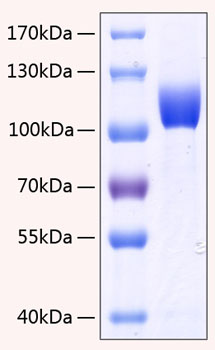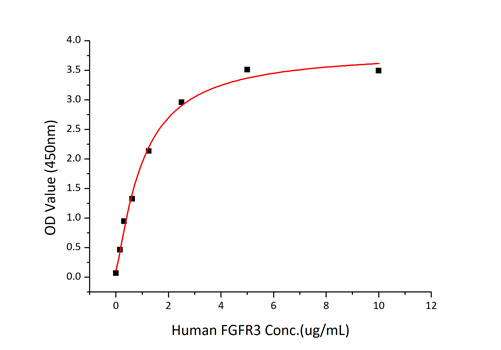Description
Recombinant Human FGFR-3 alpha (IIIc)/CD333 Protein
The Recombinant Human FGFR-3 alpha (IIIc)/CD333 Protein is a biologically active recombinant protein that plays a significant role in various cellular processes and signaling pathways in human biology. This protein is widely employed in immunological research, cell biology studies, protein-protein interaction analyses, and therapeutic development, providing researchers with a reliable tool for investigating FGFR-3 alpha (IIIc)/CD333 function and its implications in health and disease.
This product (SKU: RPCB0315) is produced using HEK293 cells and features a C-hFc&His tag for convenient detection and purification. The protein exhibits a calculated molecular weight of 64.93 kDa with an observed molecular weight of 100-120 kDa under denaturing conditions, achieving ≥ 90 % as determined by SDS-PAGE.. Functional bioactivity has been validated through rigorous quality control assays, confirming its suitability for demanding research applications.
Key Features
| High Purity by Affinity Chromatography | |
| Mammalian & Bacterial Expression Systems | |
| High lot-to-lot consistency via strict QC |
| Product Name: | Recombinant Human FGFR-3 alpha (IIIc)/CD333 Protein |
| SKU: | RPCB0315 |
| Size: | 50 μg , 100 μg |
| Reactivity: | Human |
| Synonyms: | ACH, CD333, CEK2, HSFGFR3EX, JTK4, FGFR3 |
| Tag: | C-hFc&His |
| Expression Host: | HEK293 cells |
| Calculated MW: | 64.93 kDa |
| Observed MW: | 100-120 kDa |
| Gene ID: | 2261 |
| Protein Description: | High quality, high purity and low endotoxin recombinant Recombinant Human FGFR-3 alpha (IIIc)/CD333 Protein (RPCB0315), tested reactivity in HEK293 cells and has been validated in SDS-PAGE.100% guaranteed. |
| Endotoxin: | < 0.1 EU/μg of the protein by LAL method. |
| Purity: | ≥ 90 % as determined by SDS-PAGE. |
| Formulation: | Lyophilized from a 0.22 μm filtered solution of PBS, pH 7.4.Contact us for customized product form or formulation. |
| Bio-Activity: | Measured by its binding ability in a functional ELISA. Immobilized Recombinant Human FGF1 at 5 μg/mL (100 μL/well) can bind Recombinant Human FGFR3 with a linear range of 0.5-1.5 μg/mL. |
| Reconstitution: | Centrifuge the vial before opening. Reconstitute to a concentration of 0.1-0.5 mg/mL in sterile distilled water. Avoid vortex or vigorously pipetting the protein. For long term storage, it is recommended to add a carrier protein or stablizer (e.g. 0.1% BSA, 5% HSA, 10% FBS or 5% Trehalose), and aliquot the reconstituted protein solution to minimize free-thaw cycles. |
| Storage: | Store at -20℃.Store the lyophilized protein at -20℃ to -80 ℃ up to 1 year from the date of receipt. After reconstitution, the protein solution is stable at -20℃ for 3 months, at 2-8℃ for up to 1 week. |
FGFR3, also known as CD333, is a member of the fibroblast growth factor receptor (FGFR) family, with its amino acid sequence being highly conserved between members and among divergent species. FGFR family members differ from one another in their ligand affinities and tissue distribution. FGFRs are transmembrane catalytic receptors that have intracellular tyrosine kinase activity. A full-length representative protein would consist of an extracellular region, composed of three immunoglobulin-like domains, a single hydrophobic membrane-spanning segment and a cytoplasmic tyrosine kinase domain. The extracellular portion of the protein interacts with fibroblast growth factors, setting in motion a cascade of downstream signals, ultimately influencing mitogenesis and differentiation. This particular family member binds acidic and basic fibroblast growth hormone and plays a role in bone development and maintenance. Mutations in FGFR3 gene lead to craniosynostosis and multiple types of skeletal dysplasia.








